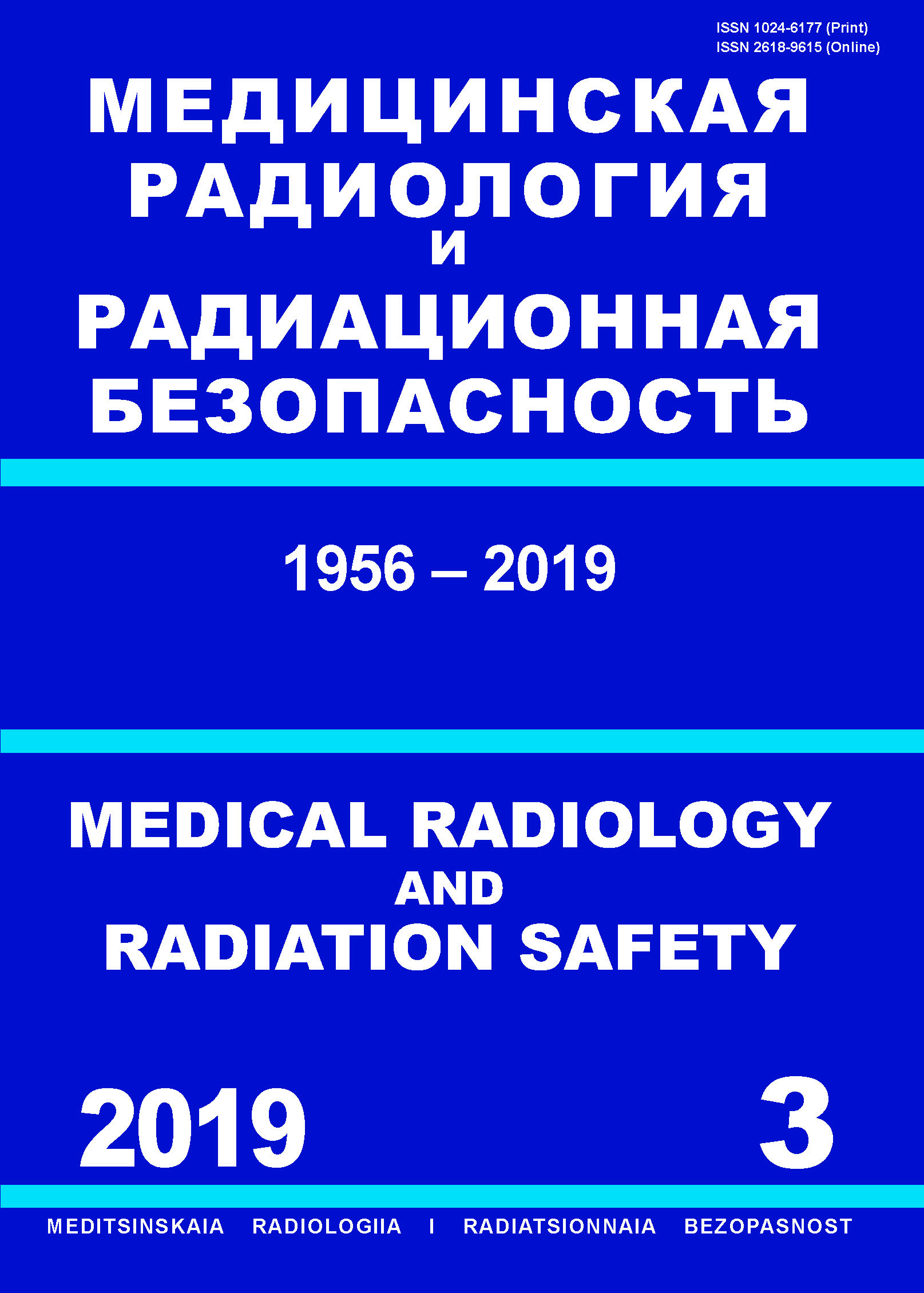Russian Federation
Russian Federation
Russian Federation
M.V. Lomonosov Moscow State University (D.V. Skobeltsyn Institute of Nuclear Physics, Researcher)
Russian Federation
Russian Federation
Russian Federation
CSCSTI 76.03
CSCSTI 76.33
Russian Classification of Professions by Education 14.04.02
Russian Classification of Professions by Education 31.06.2001
Russian Classification of Professions by Education 31.08.08
Russian Classification of Professions by Education 32.08.12
Russian Library and Bibliographic Classification 51
Russian Library and Bibliographic Classification 534
Russian Trade and Bibliographic Classification 5708
Russian Trade and Bibliographic Classification 5712
Russian Trade and Bibliographic Classification 5734
Russian Trade and Bibliographic Classification 6212
Purpose: Accurate establishing the value of relative biological effectiveness (RBE) for high energy protons is one of the main challenges of modern radiotherapy. The purpose of the study is to calculate the depth dependence of RBE for proton beams forming a spread-out Bragg peak. Material and methods: Spatial distributions of absorbed dose and dose-average linear energy transfer (LET) for 50-100 MeV (0.5 MeV energy step) monochromatic proton beams were obtained by Monte-Carlo computer simulation using Geant4 software. A linear dependence of RBE on the dose-average LET was used. Absorbed dose distributions were obtained in a water phantom for monochromatic pencil proton beams of 2.5 mm radius. The absorbed dose and the dose-average LET values were calculated in voxels with dimensions of 2×2×0.2 mm. Results: Calculations of depth dependencies of absorbed dose and dose-average LET for 50–100 MeV monochromatic proton beams were performed. Depth dependencies of RBE for these beams were established. The weighing coefficients values allowing to generate uniformspread-out Bragg peak (SOBP) were determined. Depth distribution of RBE-weighted dose and RBE values for SOBP were found. Conclusion: The impact of the initial beam energy step on the degree of homogeneity of the modified Bragg curve was investigated. It was shown that a step up to 1.5 MeV is acceptable for generate a smooth Bragg curve. The depth dependence of the average RBE value is a complex function, which rapidly changes especially at the far end of the SOBP. RBE may vary up to 10-30 % compared to current clinical value. The linear model of RBE–LET dependence shown in the study can be easily used in dosimetric planning systems, that may will significantly improve the quality of proton radiotherapy.
proton radiotherapy, relative biological effectiveness, linear energy transfer, spread-out Bragg peak, Monte-Carlo method, Geant4
1. Amaldi U. Future trends in cancer therapy with particle accelerators. Med Phys. 2004;14(1):7-16. DOI:https://doi.org/10.1078/0939-3889-00193.
2. Klimanov VA, Galjautdinova JJ, Zabelin MV. Proton radiotherapy: current status and future prospects. Med. Phys. 2017;2(74):89-121. (Russian).
3. Scholz M. Heavy ion tumour therapy. Nucl Instrum Methods Phys Res B. 2000;161-163:76-82. DOI:https://doi.org/10.1016/S0168-583X(99)00669-2.
4. Paganetti H, Niemierko A, Ancukiewicz M, Gerweck LE, Goitein M, Loeffler JS, Suit HD. Relative biological effectiveness (RBE) values for proton beam therapy. Int J Radiat Oncol Biol Phys. 2002;53(2):407-21. DOI:https://doi.org/10.1016/S0360-3016(02)02754-2.
5. Goodhead DT. Energy deposition stochastics and track structure: what about the target? Radiat Prot Dosimetry. 2006;122(1-4):3-15. DOI:https://doi.org/10.1093/rpd/ncl498.
6. Krämer M, Weyrather WK, Scholz M. The increased biological effectiveness of heavy charged particles: from radiobiology to treatment planning. Technol Cancer Res Treat. 2003;2(5):427-36. DOI:https://doi.org/10.1177/153303460300200507.
7. Paganetti H. Relative biological effectiveness (RBE) values for proton beam therapy. Variations as a function of biological endpoint, dose, and linear energy transfer. Phys Med Biol. 2014;59(22):R419-72. DOI:https://doi.org/10.1088/0031-9155/59/22/R419.
8. Paganetti H, Giantsoudi D. Relative biological effectiveness uncertainties and implications for beam arrangements and dose constraints in proton therapy. Semin Radiat Oncol. 2018;28(3):256-63. DOI:https://doi.org/10.1016/j.semradonc.2018.02.010.
9. Lühr A, von Neubeck C, Krause M, Troost EGC. Relative biological effectiveness in proton beam therapy - Current knowledge and future challenges. Clin Transl Radiat Oncol. 2018;9:35-41. DOI:https://doi.org/10.1016/j.ctro.2018.01.006.
10. Wouters BG, Skarsgard LD, Gerweck LE, Carabe-Fernandez A, Wong M, Durand RE, et al. Radiobiological intercomparison of the 160 MeV and 230 MeV proton therapy beams at the Harvard Cyclotron Laboratory and at Massachusetts General Hospital. Radiat Res. 2015;183(2):174-87. DOI:https://doi.org/10.1667/RR13795.1.
11. Wedenberg M, Toma-Dasu I. Disregarding RBE variation in treatment plan comparison may lead to bias in favor of proton plans. Med Phys. 2014;41(9):091706. DOI:https://doi.org/10.1118/1.4892930
12. Paganetti H. Relating proton treatments to photon treatments via the relative biological effectiveness should we revise current clinical practice? Int J Radiat Oncol Biol Phys. 2015;91(5):892-4. DOI:https://doi.org/10.1016/j.ijrobp.2014.11.021.
13. Cortes-Giraldo MA, Carabe AA. Critical study of different Monte Carlo scoring methods of dose average linear-energy-transfer maps calculated in voxelized geometries irradiated with clinical proton beams. Phys Med Biol. 2015;60(7):2645-69. DOI:https://doi.org/10.1088/0031-9155/60/7/2645
14. Granville DA, Sawakuchi GO. Comparison of linear energy transfer scoring techniques in Monte Carlo simulations of proton beams. Phys Med Biol. 2015;60(14):N283-91. DOI:https://doi.org/10.1088/0031-9155/60/14/N283.
15. Hawkins RB. A microdosimetric-kinetic theory of the dependence of the RBE for cell death on LET. Med Phys. 1998;25(7 Pt 1):1157-70. DOI:https://doi.org/10.1118/1.598307.
16. Wilkens JJ, Oelfke U. A phenomenological model for the relative biological effectiveness in therapeutic proton beams. Phys Med Biol. 2004;49(13):2811-25. DOI:https://doi.org/10.1088/0031-9155/49/13/004.
17. Grassberger C, Trofimov A, Lomax A, Paganetti H. Variations in linear energy transfer within clinical proton therapy fields and the potential for biological treatment planning. Int J Radiat Oncol Biol Phys. 2011;80(5):1559-66. DOI:https://doi.org/10.1016/j.ijrobp.2010.10.027.
18. Wedenberg M, Lind BK, Hårdemark B. A model for the relative biological effectiveness of protons: the tissue specific parameter α/β of photons is a predictor for the sensitivity to LET changes. Acta Oncol. 2013 Apr;52(3):580-8. DOI:https://doi.org/10.3109/0284186X.2012.705892.
19. Belousov AV, Krusanov GA, Chernyaev AP. Calculation of the proton biological efficiency in thin layer of biological tissues. Med Fizika. 2018;2(78):5-11. (Russian).
20. Allison J, Amako K, Apostolakis J, Arce P, Asai M, Aso T, et al. Recent developments in Geant4. Nucl Instrum Methods Phys Res A. 2016;835:186-225. DOI:https://doi.org/10.1016/j.nima.2016.06.125.
21. Sadovnichy VA, Tikhonravov AV, Voevodin VV, Opanasenko VY. “Lomonosov”: supercomputing at Moscow State University. In contemporary high-performance computing: from petascale toward exascale. Boca Raton: CRC Press; 2013.
22. Jette D, Chen W. Creating a spread-out Bragg peak in proton beams. Phys Med Biol. 2011;56(11):N131-8. DOI:https://doi.org/10.1088/0031-9155/56/11/N01.





